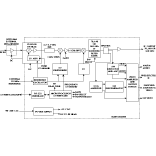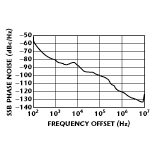A Low Cost Millimeter-wave Receiver
Communication Solutions Inc.
Baltimore, MD
A low cost millimeter-wave receiver intended for military satellite communications (MILSATCOM) downlink or terrestrial microwave link monitoring applications has been developed. This new receiver represents a major breakthrough in lowering the cost per gigahertz of this type of receiver. Typically, users employ millimeter-wave block downconverters ahead of a microwave receiver to cover the 18 to 40 GHz frequency range. These block downconverters can cost from $25 K to $50 K, adding to the $50 K to $100 K cost of the associated microwave receiver. The model CS-5106 millimeter-wave receiver is a complete millimeter-wave unit that sells for $35 K to $50 K depending on the frequency band, configuration and options.
Design Description
The new millimeter-wave receiver's design is based on a triple frequency conversion scheme, providing 1 kHz tuning resolution. Various millimeter-wave bands are downconverted to two intermediate IFs and then to a final IF of either 70, 140 or 160 MHz depending on the option selected. Additional options are available to provide FM video, AM/FM/LOG switched video, predetected IF and audio outputs. The sum of these various options makes up the complete compact millimeter-wave receiver. Figure 1 shows a simplified block diagram of the receiver.
conversion scheme, providing 1 kHz tuning resolution. Various millimeter-wave bands are downconverted to two intermediate IFs and then to a final IF of either 70, 140 or 160 MHz depending on the option selected. Additional options are available to provide FM video, AM/FM/LOG switched video, predetected IF and audio outputs. The sum of these various options makes up the complete compact millimeter-wave receiver. Figure 1 shows a simplified block diagram of the receiver.
The receiver's front-end module (RF head) uses a proprietary LO/mixing design to downconvert the input millimeter-wave band segments to the 3.2 to 3.4 GHz range. The RF head can be configured as a plug-in module to the receiver's main chassis or as a separate assembly for mounting at the antenna. Eight different RF heads are available to cover the 18 to 40 GHz frequency range in 3.2 GHz wide frequency bands. (Frequency bands above 40 GHz are available as an option.) Table 1 lists the individual frequency bands and associated CS-5106 model designations. While these RF heads provide a tunable front end covering a 3.2 GHz band in 200 MHz steps, a lower cost option is available using fixed-tuned LOs that block downconverts a user-selected and factory-installed 200 MHz wide segment.
|
Table I | |
|
Model Number (CS-510-) |
Frequency Range (GHz) |
|
T-19.0 |
17.4 to 20.6 |
|
T-22.0 |
20.4 to 23.6 |
|
T-25.0 |
23.4 to 26.6 |
|
T-28.0 |
26.4 to 29.6 |
|
T-31.0 |
29.4 to 32.6 |
|
T-34.0 |
32.4 to 35.6 |
|
T-37.0 |
35.4 to 38.6 |
|
T-40.0 |
38.4 to 40.6 |
The RF front-end module output is bandpass filtered and mixed with a 2.2 to 2.4 GHz synthesized LO to produce the second IF centered at 1 GHz. The LO tunes in 1 kHz steps. The 1 GHz IF is amplified, passed through a digitally controlled variable attenuator and filtered to a bandwidth of 50 MHz.
The final conversion stage mixes the 1 GHz IF with the appropriate LO frequency to produce a final IF of either 70, 140 or 160 MHz. The LO can be configured for either high side or low side injection to provide either an upright or inverted spectrum. The output of the third mixer passes through one of four selectable IF bandwidths at 7.5, 15, 30 or 50 MHz and a final IF amplifier, and
frequency to produce a final IF of either 70, 140 or 160 MHz. The LO can be configured for either high side or low side injection to provide either an upright or inverted spectrum. The output of the third mixer passes through one of four selectable IF bandwidths at 7.5, 15, 30 or 50 MHz and a final IF amplifier, and  then is routed to a rear-panel IF output connector. RF-to-IF gain is 25 dB (nom) with an IF output level of -20 dBm. Figure 2 shows actual measured gain and noise figure performance over the 17.4 to 20.6 GHz frequency band. Figure 3 shows the receiver's single-sideband
then is routed to a rear-panel IF output connector. RF-to-IF gain is 25 dB (nom) with an IF output level of -20 dBm. Figure 2 shows actual measured gain and noise figure performance over the 17.4 to 20.6 GHz frequency band. Figure 3 shows the receiver's single-sideband (SSB) phase noise at 17.4 GHz.
(SSB) phase noise at 17.4 GHz.
The 70, 140 or 160 MHz IF also is routed to an internal demodulator that contains a log amplifier, wide- and medium-band FM discriminators, an AM detector, automatic gain control and a video amplifier. FM video is always present on a rear-panel output connector and an output connector is provided for switch-selectable AM video, FM video or log outputs. A separate output provides AM/FM audio.
All of the receiver LOs are phase locked to an internal 100 MHz reference oscillator. In turn, this oscillator may be calibrated to an external 10 MHz reference signal for increased accuracy and stability. A single power supply provides +15 V DC from a 90 to 260 V AC primary power source. The +15 V DC is further regulated to lower voltages for bias and microprocessor requirements. A remote control interface port is provided for operator interaction.
Applications
 The CS-5106 receiver is designed for signal intercept applications where the user is concerned about front-to-back-end fidelity, including the reception of complex, high data rate, digitally formatted signals, such as quadrature amplitude modulation, where very low bit error rate performance (to within two decibels or better from theoretical) is expected. The receiver meets these requirements as a result of its low total RF input to IF output group delay. Figure 4 shows the unit's group delay for a 50 MHz IF bandwidth.
The CS-5106 receiver is designed for signal intercept applications where the user is concerned about front-to-back-end fidelity, including the reception of complex, high data rate, digitally formatted signals, such as quadrature amplitude modulation, where very low bit error rate performance (to within two decibels or better from theoretical) is expected. The receiver meets these requirements as a result of its low total RF input to IF output group delay. Figure 4 shows the unit's group delay for a 50 MHz IF bandwidth.
The receiver is particularly adaptable to use in the field because of its compact size and the flexibility of quickly plugging in different tuning heads to cover various frequency bands. The ability to locate the tuning head at the antenna or select low noise external preamplifiers for maximum sensitivity is also a valuable attribute in field service. In addition, the unit is designed primarily for portable laptop or PC workstation control. Thus, the receiver can be installed in an instrument case for field use in small transportable systems or rack mounted at fixed sites in larger systems. The Windows NT graphic user interface (GUI), shown in Figure 5 , includes a receiver control panel and a snapshot spectral display of the log video output. This snapshot output provides a useful on-the-spot analysis tool for determining signal characteristics. A built-in test screen is also provided that indicates specified operating voltages vs. actual voltages, LO lock status, loaded software version and unit operating temperature.
use in small transportable systems or rack mounted at fixed sites in larger systems. The Windows NT graphic user interface (GUI), shown in Figure 5 , includes a receiver control panel and a snapshot spectral display of the log video output. This snapshot output provides a useful on-the-spot analysis tool for determining signal characteristics. A built-in test screen is also provided that indicates specified operating voltages vs. actual voltages, LO lock status, loaded software version and unit operating temperature.
Conclusion
A versatile low cost millimeter-wave receiver is now available for MILSATCOM and terrestrial applications. Capable of operating over 3.2 GHz bands from 18 to 40 GHz or higher, the CS-5106 receiver's 1.75" x 8.50" x 23.00" compact package (excluding connectors and handles) and 12 lb weight make it particularly useful for field applications. Consult the factory for price and delivery and a complete list of available options.
Communication Solutions Inc.,
Baltimore, MD
(410) 574-4557.
